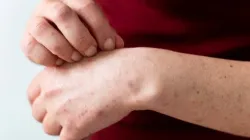What is dermatomyositis? Know symptoms and causes of this rare autoimmune disorder
With early diagnosis and appropriate management, many people with dermatomyositis can achieve remission or significant improvement in symptoms. However, it may require long-term treatment and monitoring to maintain control over the disease.

The 'Dangal' fame actress Suhani Bhatnagar, who portrayed the role of young Babita Phogat has recently died after battling with a rare disease known as Dermatomyositis. It is a rare autoimmune disease that primarily affects the skin and muscles. It's characterised by muscle weakness and skin rash. The exact cause is unknown, but it's believed to involve a combination of genetic and environmental factors triggering the immune system to attack healthy tissues.
Symptoms of Dermatomyositis
According to Dr K. Somnath Gupta, Sr. Consultant Physician & Diabetology, Yashoda Hospitals, Hyderabad, the hallmark symptom of dermatomyositis is a distinctive skin rash, typically appearing on the face, eyelids, knuckles, elbows, knees, chest, and back. This rash often presents as purple or reddish patches, often referred to as a heliotrope rash, and can be accompanied by swelling. Another common skin manifestation is Gottron's papules, which are raised, scaly patches that appear over the knuckles, elbows, or knees.
Muscle weakness is another prominent feature of dermatomyositis, affecting proximal muscles (those closest to the trunk of the body), such as those in the shoulders, hips, and thighs. This weakness can lead to difficulty rising from a seated position, climbing stairs, lifting objects, or reaching overhead. In severe cases, it can impact daily activities and quality of life.
Other symptoms may include fatigue, difficulty swallowing (dysphagia) due to muscle weakness in the throat, joint pain, fevers, weight loss, and inflammation of the lungs (interstitial lung disease).
How to diagnose Dermatomyositis?
Diagnosis typically involves a combination of clinical evaluation, blood tests to detect muscle enzyme levels and specific antibodies associated with the condition, electromyography (EMG) to assess muscle function, imaging studies such as MRI or CT scans, and sometimes a muscle biopsy to examine tissue for characteristic changes.
Treatment for Dermatomyositis
Treatment aims to suppress the autoimmune response, alleviate symptoms, and prevent complications. Corticosteroids are often the first line of treatment to reduce inflammation, along with immunosuppressive medications such as methotrexate, azathioprine, or mycophenolate mofetil to dampen the immune system's activity. Physical therapy can help maintain muscle strength and mobility, while occupational therapy can assist with activities of daily living.
Long-term management may require ongoing medication adjustments and regular monitoring for potential complications, such as infections or medication side effects. In some cases, intravenous immunoglobulin (IVIG) therapy or biologic agents may be used for refractory cases. Prognosis varies widely depending on factors such as the severity of muscle involvement, response to treatment, and presence of complications like interstitial lung disease or cancer-associated dermatomyositis.
Also Read: Protein-rich breakfast can increase satiety and improve concentration: Study
Also Read: Superfood Pistachios: Know THESE 5 benefits of Pista